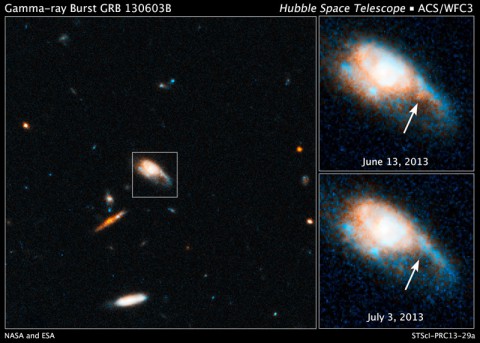 Washington, D.C. – A new kind of stellar blast called a kilonova, which happens when a pair of compact objects such as neutron stars crash together, has been detected by NASA’s Hubble Space Telescope. Hubble observed the fading fireball from a kilonova last month, following a short gamma ray burst (GRB) in a galaxy almost 4 billion light-years from Earth.
Washington, D.C. – A new kind of stellar blast called a kilonova, which happens when a pair of compact objects such as neutron stars crash together, has been detected by NASA’s Hubble Space Telescope. Hubble observed the fading fireball from a kilonova last month, following a short gamma ray burst (GRB) in a galaxy almost 4 billion light-years from Earth.
“This observation finally solves the mystery of short gamma ray bursts,” says Nial Tanvir of the University of Leicester in the United Kingdom, who led a team of researchers conducting this research.

“Many astronomers, including our group, have already provided a great deal of evidence that long-duration gamma ray bursts (those lasting more than two seconds) are produced by the collapse of extremely massive stars,” explains Tanvir.
The short bursts, however, were more mysterious.
“We only had weak circumstantial evidence that short bursts [might be] produced by the merger of compact objects,” he adds. “This result now appears to provide definitive proof.”
Astrophysicists have predicted short-duration GRBs are created when a pair of super-dense neutron stars in a binary system spiral together. This event happens as the system emits gravitational radiation, creating tiny waves in the fabric of space-time.
The energy dissipated by the waves causes the two stars to sweep closer together. In the final milliseconds before the explosion, the two stars merge into a death spiral that kicks out highly radioactive material. This material heats up and expands, emitting a burst of light.

The resulting “kilonova” is about 1,000 times brighter than a regular nova, which is caused by the eruption of a white dwarf.
In a recent science paper Jennifer Barnes and Daniel Kasen of the University of California at Berkeley and the Lawrence Berkeley National Laboratory presented new calculations predicting how kilonovas should look. They predicted the same hot plasma producing the radiation also will block the visible light, causing the gusher of energy from the kilonova to flood out in near-infrared light over several days.
From June 12th-13th, Hubble searched the location of the initial burst, spotting a faint red object. An independent analysis of the data from another research team confirmed the detection.
Subsequent Hubble observations on July 3rd revealed the source had faded away, therefore providing the key evidence the infrared glow was from an explosion accompanying the merger of two objects.
The team’s results appeared August 3rd in a special online publication of the journal Nature.
Written by Dr. Tony Phillips
Science at NASA


